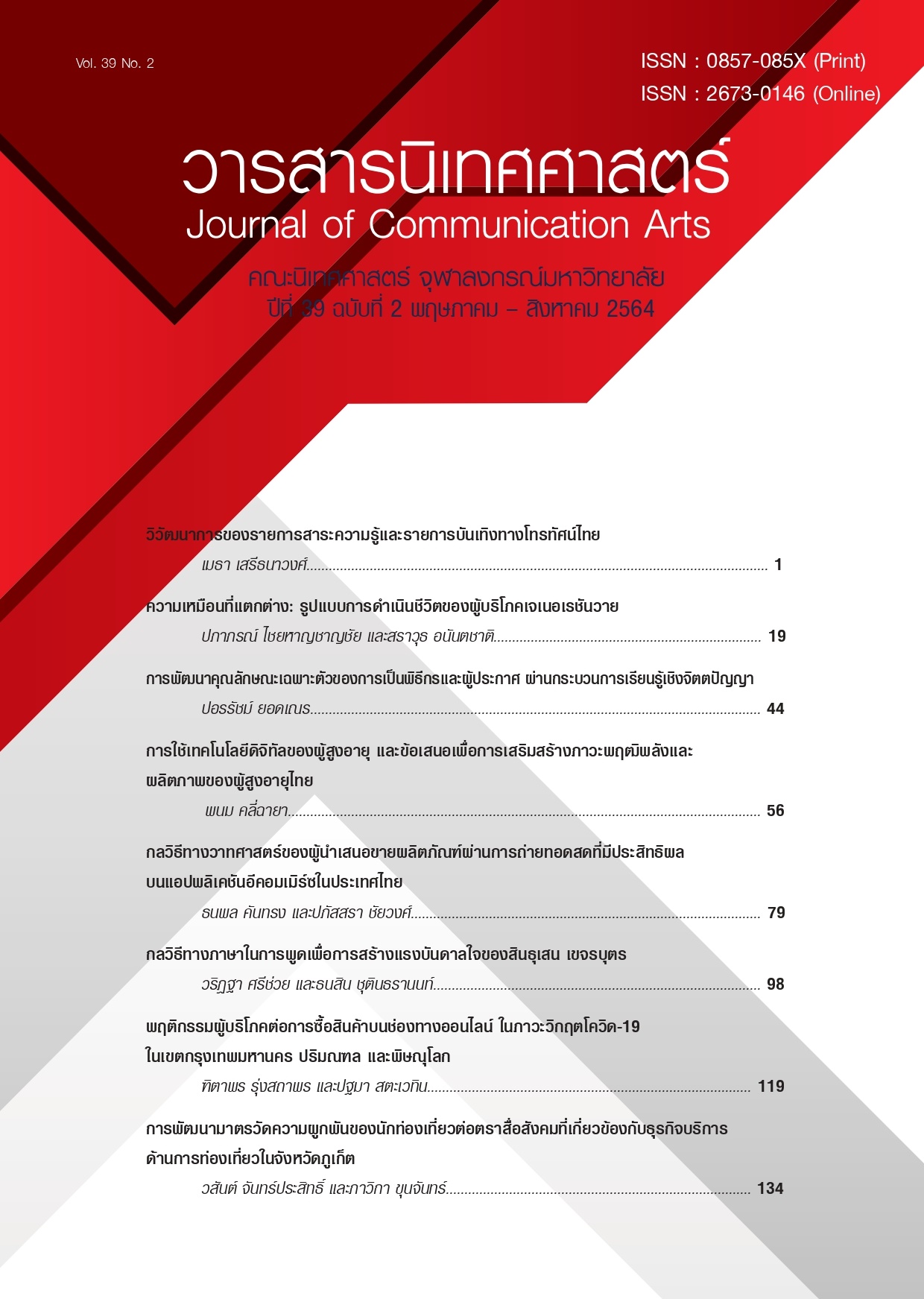The Evolution of Information Program and Entertainment Program in Thai Television
Main Article Content
Abstract
The purposes of this research are: 1) to study the evolution of information television program, and 2) to study the evolution of entertainment television program, using genre theories, information TV program concepts, and entertainment TV program concepts as the research framework. Through documental research and in-depth interviews with 28 TV program producers, the descriptive analysis reveals the history and the development Thai TV program during the course of sixty years from 2498 to 2558 BE.
The study finds that the evolution of information program is apparent both in quality and number. In terms of quality, the content of information program does not only focus on giving knowledge, but it also stimulates thought and draws public concern to social issues by means of storytelling through visual aesthetics and story. In term of number, the growing number of information program has resulted in the foundation of educational television station. An increasing number of information program in free TV, information channel in cable TV and digital TV is a remarkable phenomena that provides more opportunities in learning about oneself and the society which is the main purpose of information program. Regarding the evolution of entertainment program, an intermixing between diverse contents, genres and forms is a way that producers employs to create viewing pleasure for the audiences. Some entertainment program format has diminished and eventually disappeared from the television. The TV producers have to be innovative to compete with other free TV producers and to cross over to the online platform.
Article Details
References
กาญจนา แก้วเทพ. (2542). การวิเคราะห์สื่อ: แนวคิดและเทคนิค. พิมพ์ครั้งที่ 2. กรุงเทพฯ: เอดิสัน เพรส โพรดักส์.
ธีระ บุญพิทักษ์ และคณะ. (2541). 40 ปี สถานีวิทยุโทรทัศน์กองทัพบก. กรุงเทพฯ: มายด์พับลิชชิ่ง.
พรสวรรค์ อุทารวุฒิพงศ์. (2535). บทบาทหน้าที่ของกรมประชาสัมพันธ์ในฐานะองค์กรสื่อสารมวลชน. วิทยานิพนธ์ปริญญามหาบัณฑิต ภาควิชาการสื่อสารมวลชน จุฬาลงกรณ์มหาวิทยาลัย.
พระราชบัญญัติองค์การกระจายเสียงและแพร่ภาพสาธารณะแห่งประเทศไทย พ.ศ.2551. (2551, 14 มกราคม). ราชกิจจานุเบกษา. เล่มที่ 125 ตอนที่ 8 ก. หน้า 1-24.
ฝ่ายประชาสัมพันธ์ ช่อง 3. (2533). ครบรอบ 20 ปี สถานีวิทยุโทรทัศน์ไทยทีวีสีช่อง 3 26 มีนาคม 2533. กรุงเทพฯ: โรงพิมพ์สารมวลชน.
วัชระ สันตกมลพงศ์ และ ไขศรี วิสุทธิพิเนตร. (2555). ยุค 1 ไทยโทรทัศน์. ใน วิรัตน์ นาคชาติ และจารุจิต นวพันธุ์, บรรณาธิการ. 60 ปี ไทยโทรทัศน์ 35 ปี อสมท, 27-105. กรุงเทพฯ: เมคอะวิช.
วิชาการ, กรม. (2531). ศิลปะการละครเบื้องต้น 1-2 ตอนที่ 1. พิมพ์ครั้งที่ 5. กรุงเทพฯ: โรงพิมพ์คุรุสภาลาดพร้าว.
สินิทธ์ สิทธิรักษ์. (2543). กำเนิดโทรทัศน์ไทย (พ.ศ.2493-2500). พิมพ์ครั้งที่ 3. กรุงเทพฯ: สำนักพิมพ์มหาวิทยาลัยธรรมศาสตร์.
เสงี่ยม เผ่าทองศุข. (2526). อนุสรณ์ครบรอบ 50 ปี ของการแต่งงาน เสงี่ยม-วัฒนา เผ่าทองศุข. กรุงเทพฯ: เรือนแก้วการพิมพ์.
อุบลรัตน์ ศิริยุวศักดิ์. (2536). อารมณ์ขันในสื่อมวลชน. กรุงเทพฯ: โครงการหนังสือชุดวิจัยและพัฒนานิเทศศาสตร์.
อุบลรัตน์ ศิริยุวศักดิ์. (2542). ระบบวิทยุและโทรทัศน์ไทย: โครงสร้างทางเศรษฐกิจการเมืองและผลกระทบต่อสิทธิเสรีภาพ. กรุงเทพฯ: จุฬาลงกรณ์มหาวิทยาลัย.
อุบลรัตน์ ศิริยุวศักดิ์. (2550). สื่อสารมวลชนเบื้องต้น: สื่อมวลชน วัฒนธรรม และสังคม. พิมพ์ครั้งที่ 2. กรุงเทพฯ: จุฬาลงกรณ์มหาวิทยาลัย.
Bignell, J. and Orlebar, J. (2005). The Television Handbook. 3rd ed. New York: Taylor & Francis.
Burton, G. (2000). Talking Television: An Introduction to the Study of Television. London: Arnold.
Casey, B. et al. (2008). Television Studies: The Key Concepts. 2nd ed. London: Routledge.
Creeber, G. (Ed.) (2015). The Television Genre Book. 3rd ed. London: BFI Palgrave.
De Jong, W., Knudsen, E. & Rothwell, J. (2012). Creative Documentary: Theory and Practice. Harlow: Pearson Education Ltd.
Lindenmuth, K.J. (2010). The Documentary Moviemaking Course: The Starter Guide to Documentary Filmmaking. Hauppauge, NY: Barron’s.
Neale, S. (2000). Genre and Hollywood. London: Routledge.
Nichols, B. (2010). Introduction to Documentary. 2nd ed. Bloomington, IN: Indiana University Press.
O’Donnell, V. (2013). Television Criticism. 2nd ed. Thousand Oaks, CA: SAGE.
Orlebar, J. (2011). The Television Handbook. 4th ed. London; New York: Routledge.
Tunstall, J. (1993). Television Producers. London: Routledge.
Wober, J.M. (1988). The Use and Abuse of Television: A Social Psychological Analysis of the Changing Screen. Hillsdale, NJ: Lawrence Erlbaum Associates.


